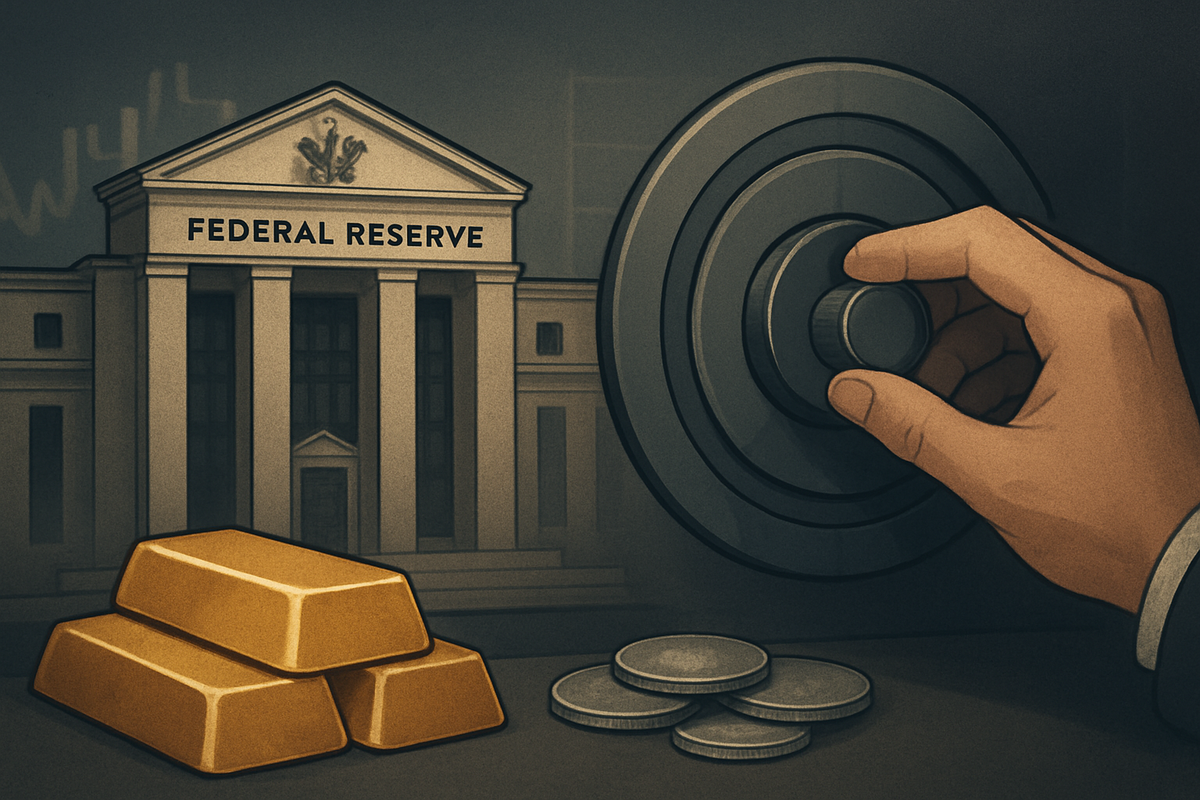
New York, NY – November 17, 2025 – The financial markets are currently grappling with a significant shift in expectations regarding the Federal Reserve's interest rate policy. While the Fed has already implemented several rate cuts throughout 2024 and into 2025, the likelihood of a further cut in December 2025 has diminished considerably. This recalibration of market sentiment is sending ripples across various asset classes, with precious metals like gold and silver experiencing immediate downward pressure as their appeal wanes in an environment of potentially higher-for-longer interest rates.
The reduced conviction in a year-end rate cut stems from a combination of factors, including more hawkish commentary from Federal Reserve officials, the resolution of a prolonged government shutdown, and unexpectedly robust economic data. These developments are forcing investors to reassess their portfolios, particularly their exposure to non-yielding assets, and are setting the stage for a potentially volatile end to the year.
Rate Cut Hopes Fade as Fed Signals Caution
The Federal Reserve has been actively adjusting its monetary policy, with a full percentage point reduction in the benchmark rate across 2024 and an additional 25 basis point (bps) cut in October 2025, bringing the federal funds rate target range to 3.75%-4.00%. However, the market's earlier strong conviction for a December 2025 rate cut, which hovered between 70% and 95% just a month ago, has now plummeted to approximately 40-50%. This dramatic shift suggests that the central bank might opt to hold rates steady at its upcoming meeting.
This altered outlook is largely attributable to recent hawkish pronouncements from key Fed figures. Chairman Jerome Powell has explicitly stated that a December rate cut is "not a foregone conclusion," echoing sentiments from other officials. Notably, Kansas City Fed President Jeffrey Schmid, a voting member, voiced concerns about the potential for further cuts to exacerbate inflation and even opposed the September rate cut. These statements have effectively tempered market exuberance for continued easing.
Adding to the complexity, the recent resolution of a 41-day U.S. government shutdown in October 2025 has introduced new dynamics. While the shutdown initially fostered uncertainty and spurred safe-haven demand for precious metals due to a "data fog" from delayed economic reports, its conclusion has partially alleviated this specific driver. Moreover, stronger-than-anticipated economic indicators, such as the November Empire manufacturing general business conditions survey reaching a one-year high, have lent support to the U.S. dollar and further diminished the urgency for immediate rate cuts. Despite these developments, the delay in crucial economic data, including October's labor market and inflation reports, continues to complicate the Fed's data-dependent decision-making process.
The immediate consequence for precious metals has been a notable decline. Gold prices, after experiencing their most significant daily fall in three weeks on Friday, steadied on November 17 but have still seen a 7.49% decline over the past month. Similarly, silver has faced heavy selling, dropping from an earlier peak of $54.42 to around $50.87, representing a 3.28% fall over the last month, as traders scaled back their expectations for Fed easing.
Precious Metals Miners and ETFs Face Headwinds
The diminishing prospects for Federal Reserve rate cuts have direct and significant implications for companies operating within the precious metals sector, as well as for investment vehicles tied to these commodities. Generally, a higher interest rate environment increases the opportunity cost of holding non-yielding assets like gold and silver, reducing investor demand and consequently, their prices. This scenario can weigh heavily on the profitability and valuations of mining companies and the performance of precious metal exchange-traded funds (ETFs).
Gold mining giants such as Barrick Gold Corp. (NYSE: GOLD) and Newmont Corporation (NYSE: NEM) are particularly sensitive to fluctuations in gold prices. Lower gold prices can compress their profit margins, as their operational costs remain relatively fixed. This could lead to reduced revenue, potentially impacting their ability to fund exploration projects, expand existing mines, or return capital to shareholders through dividends or buybacks. Investors in these companies may see a decline in stock performance as market sentiment shifts away from gold. Similarly, silver producers like Pan American Silver Corp. (NASDAQ: PAAS) and First Majestic Silver Corp. (NYSE: AG) face similar challenges, with silver's dual role as both a monetary and industrial metal adding another layer of complexity. While industrial demand might offer some floor, the investment appeal tied to interest rates remains a dominant factor.
Conversely, the impact extends to financial products designed to track precious metal prices. Gold ETFs such as the SPDR Gold Shares (NYSEARCA: GLD) and silver ETFs like the iShares Silver Trust (NYSEARCA: SLV) are likely to experience outflows or reduced inflows as investors seek higher-yielding alternatives. The value of shares in these ETFs directly correlates with the underlying metal prices, meaning that a sustained period of lower precious metal prices will translate into underperformance for these funds. For investors who have used these ETFs as a hedge against inflation or economic uncertainty, the reduced rate cut expectations could prompt a re-evaluation of their hedging strategies.
However, not all news is bleak for the sector. Companies with strong balance sheets, efficient operations, and lower all-in sustaining costs (AISC) may be better positioned to weather periods of lower commodity prices. Furthermore, any renewed geopolitical instability or a resurgence in inflation concerns could quickly reignite safe-haven demand, providing a potential upside for these companies and ETFs. For now, the prevailing sentiment is one of caution, as the market adjusts to a potentially less accommodative monetary policy from the Federal Reserve.
Broader Implications and Historical Context
The Federal Reserve's evolving stance on interest rates, moving away from aggressive rate cut expectations, carries wider significance beyond the immediate impact on precious metals. This shift reflects a broader economic narrative where inflation, while perhaps moderating, remains a persistent concern, and economic growth shows unexpected resilience. This scenario challenges the prevailing "lower for longer" interest rate paradigm that has characterized much of the post-financial crisis era and implies a potentially higher cost of capital across various industries.
This event fits into a broader trend of central banks globally grappling with the aftermath of unprecedented monetary stimulus. Many central banks are now navigating a delicate balance between containing inflation and avoiding a severe economic downturn. The Fed's cautious approach signals that it prioritizes price stability, even if it means maintaining a tighter monetary policy for longer than some market participants had anticipated. This could lead to a re-evaluation of growth forecasts for interest-rate sensitive sectors, from housing to technology, and may prompt companies to adjust their investment and expansion plans in response to higher borrowing costs.
Potential ripple effects could be felt across various financial markets. A stronger U.S. dollar, often a consequence of higher interest rates, could put pressure on emerging market currencies and make dollar-denominated debt more expensive for foreign borrowers. This could lead to capital outflows from emerging markets, impacting their economic stability. Furthermore, regulatory bodies and policymakers will be closely watching the impact of this monetary tightening on financial stability, particularly concerning corporate debt levels and the housing market.
Historically, periods of rising or sustained high interest rates have generally been challenging for precious metals. During the 1980s, for instance, aggressive rate hikes by the Fed under Paul Volcker to combat runaway inflation led to a significant decline in gold prices from their earlier peaks. Conversely, periods of quantitative easing and low interest rates, such as those following the 2008 financial crisis, often saw precious metals perform strongly. The current situation, while not mirroring these historical extremes, suggests a return to a more normalized interest rate environment where the opportunity cost of holding non-yielding assets is more pronounced. This historical context underscores the sensitivity of precious metals to central bank policy and the broader economic landscape.
What Comes Next: Navigating a Shifting Landscape
The coming months will be critical for investors and market participants as they navigate the evolving monetary policy landscape. In the short term, the immediate focus will be on the Federal Reserve's December meeting. Should the Fed indeed hold rates steady, or even hint at a more prolonged pause in rate cuts, it could reinforce the current downward pressure on precious metals. Conversely, any unexpected dovish signals or weaker-than-anticipated economic data could quickly reverse this trend, reigniting rate cut expectations and providing a potential boost to gold and silver.
Looking further ahead, several key factors will shape the trajectory of precious metals and the broader market. The Fed's policy will remain "data-dependent," meaning inflation reports, labor market statistics, and GDP figures will be scrutinized for clues about future rate decisions. Persistent inflation could compel the Fed to maintain higher rates, while a significant economic slowdown might force a more accommodative stance. Geopolitical developments, such as ongoing conflicts or new international tensions, could also serve as a wild card, potentially increasing safe-haven demand for gold regardless of interest rate expectations.
For companies in the precious metals sector, potential strategic pivots may include a renewed focus on cost efficiency and capital discipline. Miners might prioritize high-grade projects, optimize operational expenses, and consider hedging strategies to mitigate price volatility. Acquisitions and mergers might also pick up as stronger players look to consolidate assets in a more challenging pricing environment. For investors, this period presents both challenges and opportunities. While the immediate outlook for precious metals may be less favorable, periods of weakness can create entry points for long-term investors who believe in the intrinsic value and safe-haven properties of these assets.
Potential scenarios range from a "soft landing" for the economy, where inflation gradually subsides without a recession, leading to a prolonged period of stable but not excessively low interest rates, to a "hard landing" with a more pronounced economic downturn, which could eventually force the Fed to cut rates more aggressively. Each scenario carries different implications for precious metals, with the latter potentially offering a stronger tailwind. The market will remain highly sensitive to incoming economic data and any shifts in the Fed's communication.
Wrap-Up: A New Chapter for Precious Metals
The recent recalibration of Federal Reserve rate cut expectations marks a significant turning point for precious metals and the broader financial markets. The key takeaway is that the era of aggressively declining interest rates, which often provided a strong tailwind for gold and silver, appears to be pausing, if not ending. The Fed's commitment to tackling inflation, coupled with resilient economic data and cautious rhetoric, suggests a more disciplined and potentially higher-for-longer interest rate environment than previously anticipated.
Moving forward, investors must acknowledge that the traditional inverse relationship between interest rates and precious metals is reasserting itself with renewed vigor. While underlying factors such as geopolitical instability, central bank buying, and persistent inflation concerns may still provide some support for gold and silver as safe-haven assets and inflation hedges, the immediate gravitational pull of higher interest rates cannot be ignored. The market is currently assessing the implications of this shift, leading to a period of adjustment for precious metals prices and related equities.
The lasting impact of this event will depend on the Fed's future actions and the evolution of economic data. Should inflation prove more stubborn, or economic growth remain robust, the appeal of non-yielding assets will likely remain subdued. Conversely, any signs of economic weakness or a renewed push towards easing could quickly reverse the current sentiment. Investors should watch closely for further statements from Federal Reserve officials, upcoming inflation and employment reports, and global geopolitical developments. The market for precious metals is entering a new chapter, one where the cost of capital and the opportunity cost of holding non-yielding assets will play a more dominant role in their valuation.
This content is intended for informational purposes only and is not financial advice







